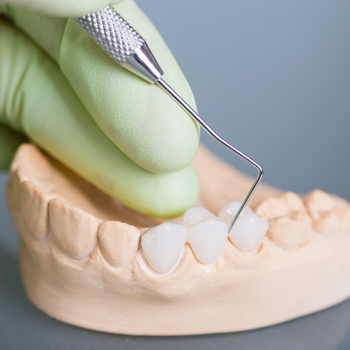Dental Bridge Dentist Livermore
A dental bridge is exactly what it sounds like: If you have missing teeth, our skilled Livermore dentist can close the gaps in your smile with dental bridges. A dental bridge is an artificial tooth (pontic) that is held in place by the supportive teeth on either side of the gap. Although pontics are made from an array of materials, like gold, they are typically made from porcelain, which aesthetically blends in with natural teeth.
Dental Bridge Benefits
A missing tooth, or missing teeth, can affect you in a number of ways. A dental bridge can address those issues by:
- fixing your smile
- fixing your ability to properly chew
- fixing your speech and pronunciation
- preserving the shape of your face
- re-modifying your bite so there is a correct distribution in force as you chew
- stopping your remaining teeth from shifting out of the correct position
Process for Obtaining a Dental Bridge

- During the first visit, the teeth supporting the bridge (abutment teeth) are prepped for the crown. Prepping involves reconstructing these teeth by removing a part of enamel. This will allow room for a crown to be positioned over them.
- Next, the dentist takes impressions of your teeth, which will be used as a model for the bridge, pontic, and crowns that will be made by a dental laboratory. A temporary bridge will be made for you to wear to protect the exposed teeth and gums while you wait for the final bridge to be made.
- Your temporary bridge will be removed during the next visit and your new, permanent bridge will be examined and adjusted, as needed, to get a proper fit.
- Depending on individual cases, some patients may be required to make several visits to check the fit of the metal framework and bite. If the dental bridge is permanent, your dentist may only temporarily cement it in place to be sure it fits properly. After a few weeks, the bridge will be permanently cemented into place.
Caring for a Dental Bridge
You can keep your dental bridge clean and prolong its life by following these tips for bridge care:
- Brush twice a day with toothpaste, morning and night
- Floss once a day and make sure to get under the false tooth, as well as between your natural teeth. You can use regular floss, but a proxy brush could be better because it is designed to get into all hard to reach places between teeth
- Get a professional cleaning from your dentist or dental hygienist regularly
- Establish a diet that is higher in fruits, vegetables, and fiber than meat
A dental bridge is made to be a solution for dental problems and chewing difficulties, which can occur following the loss of a tooth. After your dental bridge procedure, you need to be sure you brush your teeth twice a day and floss once a day in order to keep your bridge clean and reduce the risk of tooth decay, which can negatively affect your bridge. Don’t be afraid to ask your dentist about how to care for your dental bridge, if you aren’t certain, and continue routine follow-up visits so that your dentist can check up on your bridge.

Dental Bridge with our Livermore Dentists

If you’re missing a tooth or a few teeth, you should discuss the different replacement options you have with our dental bridge dentist Livermore. Dental bridges have many benefits, and there are many factors — including how much they cost — that you should think about before deciding. At Foothill Dental Care in Livermore, we view any cosmetic dentistry as an investment. Patients not only invest in their self-confidence but in their overall health. Call Foothill Dental Care at (925) 961-5484 to schedule an appointment today. It’s time to fix your smile!
Typically, a medical insurance plan will not cover a fixed bridge because it is categorized as cosmetic dentistry. A dental bridge can be crowns connected by a removable partial denture or false tooth. These dental care may not be covered by a basic dental plan.
In some cases, dental bridges can last around 15 years or longer. With great oral hygiene and regular prophylaxis, it is not unusual for the life span of a fixed bridge to be over 10 years.
You should have no trouble eating if you have a dental bridge. In fact, if the bridge is supporting new implants or dentures, it can actually improve your eating function.
